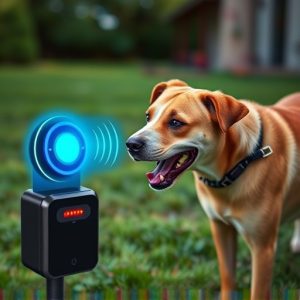Maximize Ultrasonic Dog Repellent Effectiveness: Best Placement Strategies
Ultrasonic repeller devices use high-frequency sound waves, inaudible to humans but sensed by dogs,…….
Ultrasonic repeller devices use high-frequency sound waves, inaudible to humans but sensed by dogs, to keep them away without harm. For maximum effectiveness, place them near entry points (fences, doors, etc.), at eye level or slightly elevated, and group multiple devices for larger areas. Best placement is in tranquil zones where dogs hear the sounds but humans don't. Consistent training, starting with understanding your dog's triggers and gradually exposing them to the repellent, is essential for success.
Discover the power of ultrasonic technology in keeping dogs at bay with our comprehensive guide. We explore how these innovative devices emit high-frequency sound waves, invisible to humans but unpleasant for canines, effectively deterring them from specific areas. This article delves into the best placement strategies for maximum effectiveness, along with advantages, potential drawbacks, and training tips to enhance the success of your ultrasonic dog repellent device.
- Understanding Ultrasonic Technology for Dog Repellents
- Best Placement Strategies for Maximum Effectiveness
- Advantages and Potential Drawbacks of Using Ultrasonic Repellers
- Training Tips to Accompany Ultrasonic Dog Repellent Devices
Understanding Ultrasonic Technology for Dog Repellents
Ultrasonic technology has emerged as a popular and seemingly effective solution for dog repellents, offering a non-toxic and humane approach to keeping canines at bay. This innovative method leverages high-frequency sound waves that are inaudible to humans but can be sensed by dogs. When activated, these devices emit a range of ultrasonic frequencies, creating an area where dogs are deterred from entering without causing them any harm. The technology works on the principle that dogs, being more sensitive to high-frequency sounds, will avoid zones with such emissions.
The best placement for ultrasonic repeller devices is typically in areas where dog presence is a concern but human activity is minimal. For instance, these devices can be strategically positioned in garden beds, along fences, or even inside homes in rooms frequented by dogs. It’s important to ensure that the devices are out of reach from pets and children to avoid any accidental activation or interference. Additionally, ultrasonic repellents work best when combined with other training methods, providing a multi-faceted approach to dog management and creating an environment where canines naturally prefer to stay away.
Best Placement Strategies for Maximum Effectiveness
When it comes to the best placement strategies for maximum effectiveness of ultrasonic dog repellents, consider positioning the devices near areas where dogs frequently enter or congregate. This could include fences, doors, windows, and balconies. The high-frequency sound waves travel in a horizontal direction, so placing them at eye level or slightly elevated is ideal as it covers more ground while minimizing the risk of disturbing humans or pets indoors.
Additionally, ensuring proper coverage is key. Grouping multiple repeller devices at strategic locations can create a protective barrier for larger areas. It’s also crucial to keep them away from water sources and other electronic devices to prevent any potential interference, maintaining their optimal performance.
Advantages and Potential Drawbacks of Using Ultrasonic Repellers
Ultrasonic repellers offer a unique and humane approach to keeping dogs away from specific areas, making them a popular choice among pet owners and property managers. One of the primary advantages is their ability to emit high-frequency sound waves that are inaudible to humans but irritating to dogs. This technology can effectively deter canine intrusions without causing harm or stress, making it an appealing option for those seeking non-lethal solutions. These devices are particularly useful for protecting gardens, patios, and even indoor spaces from unwanted dog visits.
However, while ultrasonic repellers have proven successful for many, there are potential drawbacks to consider. Some dogs may develop a tolerance to the sound over time, requiring adjustments in frequency or duration. Additionally, these devices might not be as effective in areas with high background noise, such as busy streets or parks, where the ultrasonic signal could get lost. The best placement for ultrasonic repeller devices is in quiet, targeted zones, ensuring the sounds are clearly heard by dogs but not disruptive to humans.
Training Tips to Accompany Ultrasonic Dog Repellent Devices
When using ultrasonic dog repellent devices, proper training is key to ensure their effectiveness. The first step is to identify and understand your dog’s trigger for unwanted behaviors, such as barking or aggression. Once identified, create a positive association with the sound emitted by the device. Start by placing the repellent in areas where the behavior occurs most frequently, ensuring it’s at the best placement for optimal range and clarity. Gradually expose your dog to the device, rewarding calm behavior while the ultrasonic tone is active. This positive reinforcement will help your dog associate the sound with a relaxing experience.
To maximize the success of this training, maintain consistency in your approach. Use the repellent during specific times or scenarios when the unwanted behavior typically arises. Be patient and persistent; it may take time for your dog to connect the tone with its intended effect. Additionally, remember that each dog is unique, so adapt these steps based on your pet’s temperament and progress. Regular training sessions will help reinforce good habits and make ultrasonic repellent devices an effective tool in modifying your dog’s behavior.
Ultrasonic repellents offer a humane and effective solution to keep dogs away from certain areas, but their success depends on optimal placement. By understanding how this technology works and implementing the best placement strategies, you can enhance its effectiveness. Regular training alongside these devices ensures positive results, creating a harmonious environment for both pets and their owners. Remember, while ultrasonic repellers have numerous advantages, being aware of potential drawbacks will help you make informed decisions to achieve the best outcomes.


